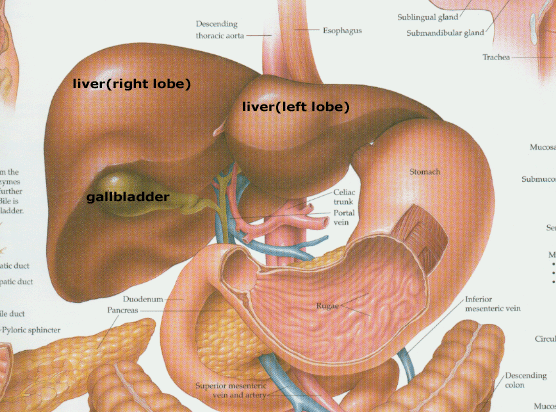Gallstones are formed from bile, a fluid composed mostly of water, bile salts, lecithin, and cholesterol. Bile is first produced by the liver and then secreted through tiny channels within the liver into a duct. From there, bile passes through a larger tube called the common duct, which leads to the small intestine. Then, except for a small amount that drains directly into the small intestine, bile flows into the gallbladder through the cystic duct. The gallbladder is a four-inch sac with a muscular wall that is located under the liver. Here, most of the fluid (about two to five cups a day) is removed, leaving a few tablespoons of concentrated bile. The gallbladder serves as a reservoir until bile is needed in the small intestine for digestion of fat. When food enters the small intestine, a hormone called cholecystokinin is released, signaling the gallbladder to contract. The force of the contraction propels the bile back through the common bile duct and then into the small intestine, where it emulsifies fatty molecules so that fat and the fat-absorbable vitamins A, D, E, and K can enter the blood stream through the intestinal lining.
About three-quarters of the gallstones found in the US population are formed from cholesterol. Cholesterol makes up only five percent of bile; it is not very soluble, however, so in order to remain suspended in fluid, it must be properly balanced with bile salts. If the liver secretes too much cholesterol into the bile, if the bile becomes stagnant and forms sludge because of a defect in the mechanisms that cause the gallbladder to empty, or if other factors are present, supersaturation can occur. Cholesterol may then precipitate out of the bile solution to form gallstones, a condition known as cholelithiasis. The process is very slow and most often painless. Gallstones can range from a few millimeters to several centimeters in diameter.
About 15% of gallstones are known as pigment stones. They are composed of calcium bilirubinate, or calcified bilirubin, the substance formed by the breakdown of hemoglobin in the blood. Pigment stones can be black or brown and often form in the gallbladders of people with hemolytic anemia or cirrhosis.
Patients may also have a mixture of pigment and cholesterol gallstones.
At any point, stones may obstruct the cystic duct, which leads from the gallbladder to the common bile duct, and cause pain (biliary colic), infection and inflammation (cholecystitis), or all of these. About 15% of people with stones in the gallbladder also have stones in the common bile duct (choledocholithiasis), which sometimes pass into the small intestine but also may lodge in the duct and cause distention, infection, or pancreatitis.
How we can help…
Ultrasound can easily detect large and small stones before they cause pain and discomfort.

